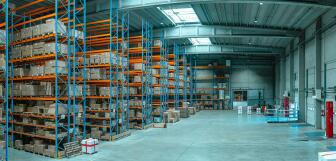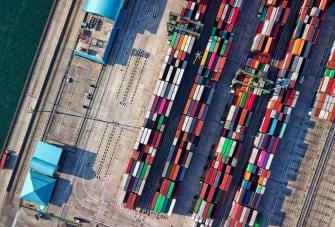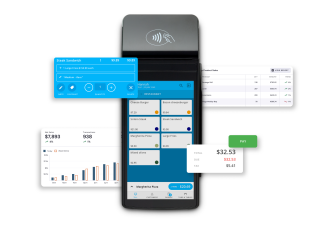Restaurant supply chain management explained
Your food. Your dishes. Your cutlery. Even that tiny paper umbrella in your cocktail. They all come from somewhere. The chicken on your plate might be from a local farm just a few miles away. The wine is probably flown in from France or Argentina. The plates you’re eating off? Manufactured in China. Even that little umbrella had its own journey - designed in one country, shipped from another, and dropped off at your bar in a bulk order of 10,000.
Every single thing in a restaurant has a story of how it got there. And that is the supply chain.
Now, managing zed supply chain might not sound like the hottest topic. I mean, who dreams of spreadsheets and logistics when opening a restaurant? But mastering it is one of the most important things you can do if you want your restaurant to actually, you know, survive.
So today, think of this as your quick-start guide to restaurant supply chain management. No jargon, no scary graphs, just the essentials you need to keep your kitchen (and your business) running smoothly.
Because when your supplies are sorted, your kitchen is sorted, and when your kitchen is sorted? Your customers are happy, your staff are sane, your business actually makes money. (isn’t that the dream?)
What is restaurant supply chain management
A supply chain, in the simplest terms, is the journey stuff takes to get from point A to point B. Raw materials get pulled from somewhere (a farm, a factory, maybe even halfway across the world), they get turned into something people actually want to buy, and then they’re delivered to the customer. That’s it. Point A → Point B → Dinner plate.
Here’s what that actually looks like in practice:
- Sourcing raw materials: Finding your farmers, wholesale food distributors, and even the people who sell you takeout containers. (Because yes, that brown paper bag has a supply chain story too.)
- Logistics: Figuring out who’s going to actually deliver those supplies to your restaurant, and when.
- Production: That’s your kitchen work. Turning raw potatoes into fries people actually want to eat.
- Distribution: Getting those fries from the fryer to the table, or these days, sometimes across town to someone’s doorstep.
- Inventory management: Keeping track of how much you have, so you know when to reorder before you run out.
Now, in a perfect world, you’d set up your suppliers, sign some contracts, and everything would just work. But, as we all learned during COVID, things don’t always go according to plan.
Farmers couldn’t harvest. Truck drivers couldn’t deliver. Suddenly, restaurants were open again but couldn’t get their hands on enough ingredients.
When supplies are low but demand is high prices shoot up in the food industry. Beef prices, for example, jumped about 20% in just three months back in 2020. That forced restaurants to either raise their own prices or take a hit on profits.
Why restaurant supply chain solutions matter
So, why is restaurant supply chain management actually important? Well, because it keeps your restaurant alive. No exaggeration. Without a working food supply chain, you can forget about smooth service, consistent food quality, or even basic product availability. Let's break it down:
Cost management and profitability
Cost management and profitability are where supply chain management in restaurants really shows its power.
When you’ve got a strong supply chain, you can negotiate better deals with your vendors. That means locking in fair prices on raw materials and building long-term supplier relationships that save you money in the long run.
It also comes down to inventory control. With the right digital tools or even full-blown supply chain software, you can actually track what’s coming in, what’s going out, and how much you really need. That’s how you avoid ordering way too much lettuce, or not enough chicken wings on game day.
Fixing overstocking and understocking can cut inventory management costs by 10%, according to recent supply chain benchmarks. Ten percent! That’s the difference between scraping by and a healthy profit margin.
Competitive advantage
A man walks into your restaurant. He’s craving your famous burger. He sits down, orders… and you’re out of beef. Oops. He’s gone. Probably straight to your competitor down the street.
This is why restaurant supply chain management matters. A strong food supply chain means your product availability is solid. Customers get what they want. Every time. No excuses. Happy customers. Repeat business. Customer loyalty.
It’s about being faster, smarter, and more reliable than everyone else. While other restaurants struggle with supply chain disruptions or messy inventory management, you’re already cooking, already serving, already winning.
That’s your competitive advantage.
Customer satisfaction
At the end of the day, food supply chain management is really about one thing: people. Your customers. When you’ve got product quality and product availability locked down, they don’t experience the dreaded “sorry, we’re out of that.” Instead, they get consistent meals, faster service, and (thanks to your behind-the-scenes hustle) better food safety.
Food safety, quality, and regulatory compliance
Imagine serving a dish your customer loves… and then they get sick. Nightmare, right? That’s why food safety isn’t optional.
A good restaurant supply chain starts with trustworthy suppliers. Working with the right suppliers means you’re getting food from people who follow strict safety standards. The ones with proper supplier certifications because if they don’t take food safety seriously, neither can you.
Good solutions also help with quality control and food safety. They make sure your suppliers are certified, your ingredients are fresh, and you’re meeting regulations without sweating through audits.
Common challenges in restaurant supply chain management
Running a restaurant supply chain isn’t all sunshine and perfectly delivered veggies to grocery stores. There are supply chain challenges. Big ones. Including:
Perishability and shelf life concerns
Ingredients like produce, meat, and dairy don’t last forever. Lettuce wilts, milk sours, fish goes off. If you order too much, it spoils before you can use it. Too little, and you run out mid-service - hello, angry customers waiting for their meals. Timing matters. Storage matters. Knowing exactly how long something stays fresh? That’s a skill every restaurant manager needs to master.
Supply chain disruptions and transportation bottlenecks
Sometimes, stuff just doesn’t arrive. Trucks break down. Roads close. Weather happens. Tariff taxes get imposed overnight. A delivery that should take a day can take a week, leaving your kitchen scrambling. Suddenly your menu isn’t what it says on the board. You might even have to replace a special with…well, nothing. This is why flexibility and backup suppliers are crucial.
Data silos and lack of visibility in supply chain operations
If your ordering, inventory, and supplier info are all in different places (or worse, in someone’s head) you don’t have the full picture. You can’t see what’s coming in, what’s running low, or what’s about to expire. It’s like cooking in the dark. You’re guessing what you have and hoping you don’t run out during dinner rush.
Fluctuating demand, seasonality, and inventory unpredictability
Customer demand isn’t even a little bit consistent. Summer crowds, holiday rushes, local festivals, or even just a random spike in orders all affects what you need. If your supply chain can’t adjust quickly, you end up overstocked, understocked, or both. Overstocked? Spoilage. Understocked? Angry customers. It’s a fine line to walk.
Best practices for efficient restaurant supply chain management
Okay, you know all the supply chain challenges that could happen. But don't worry because we're not just going to leave you stressed and panicking in the kitchen. There are ways to make your supply chain reliable, and even a little less scary.
Building and managing supplier relationships
If a stranger came up to you on the street and asked for a favor, what would you do? Probably shrug and tell them you were too busy, right?
Now, if your friend (or even a close colleague) asked for the same favor, you’d probably go out of your way to help. That’s because we naturally trust people we know and have relationships with.
It’s the same with your suppliers. When you treat them as partners rather than just delivery people, things go a lot smoother. If you build a strong relationship with your suppliers, they're more likely to help if a delivery is late, there’s a sudden spike in demand, or if you need a last-minute substitution.
Here's some tips for doing just that:
- Check in often. Don’t just call when you need something. A quick email or a call goes a long way.
- Pay on time. Honor your agreements. Suppliers respect businesses they can count on.
- Let them know about big events, seasonal spikes, or menu changes. It helps them prepare and keeps deliveries smooth.
- Treat them like partners, not just vendors. When they succeed, you succeed.
Quality control and supplier accountability
Even the very best suppliers can slip up. That’s why quality management is your safety net. You can’t just assume everything arriving at your kitchen is perfect. Checking deliveries, monitoring storage, and testing ingredients are all part of making sure your food is safe and high-quality.
Food safety management is what keeps customers healthy and your reputation intact. If something goes wrong and you have a regulatory audit via a health inspection happen, it’s on you, not your supplier. That’s why you need systems in place to catch problems before they reach the plate.
A strong quality control process and accountable suppliers make regulatory audits less stressful.
Collaboration across operations
Ever seen a kitchen where everyone’s doing their own thing? The cooks are in chaos, the servers are frustrated, the orders are all over the place. It’s messy and that mess can kill a restaurant faster than a spoiled batch of chicken.
That’s why collaboration across all parts of your restaurant matters. Your food production in the kitchen and your food manufacturing processes with suppliers need to talk to each other. If one team doesn’t know what the other is doing, ingredients can be wasted, orders delayed, and customers unhappy.
Here are some tips to make collaboration real and effective:
- Hold quick daily or weekly meetings between kitchen, front-of-house, and purchasing teams.
- Let everyone know what’s coming, like menu changes, big events, or seasonal spikes.
- Everyone should know who handles food production, who monitors inventory, and who communicates with food manufacturing suppliers.
- If something isn’t working, talk about it. The more open the communication, the smoother operations will run.
Reducing waste and improving shelf life
America throws away nearly 60 million tons of food every year. That’s almost 40% of the entire US food supply. Crazy, right?
This isn’t just bad for the planet, it’s money down the drain for restaurant owners. Spoiled ingredients, overstocked shelves, and wasted materials all hit your bottom line.
Here’s how to cut waste:
- Track inventory closely – Know what’s in stock, what’s about to expire, and what’s used most.
- Forecast demand – Use historical sales and seasonal trends to order smarter, so you’re not overstocked.
- First in, first out (FIFO) – Always use older stock first. It keeps food production flowing and reduces spoilage.
- Work with suppliers and food manufacturers: Adjust deliveries to match your actual needs and avoid excess.
- Repurpose ingredients – Turn extra veggies into soups or sauces instead of tossing them.
Contingency planning and risk mitigation
There’s this old saying: “Hope for the best, but prepare for the worst.” And if you run a restaurant, that’s basically your mantra for supply chain management.
Because here’s the truth things happen. They don't always go to plan. If you’re not ready, your kitchen screeches to a halt and your customers are stuck waiting.
So what do smart restaurants do? They have backup plans. They keep backup suppliers in their pocket. They source locally when they can. They watch agricultural reports and market trends so they know when shortages or price spikes are coming.
Here’s how to make it real:
- Have at least one alternative supplier for every key ingredient. If your main vendor fails, you’re not out of luck.
- Don’t put all your eggs in one basket. Spread your sourcing around farms, manufacturers, and distributors.
- Keep an eye on the market. Weather, crop reports, price trends all matter.
- Make a plan for disruptions. Decide what your team does if deliveries are late or ingredients run out. Maybe that’s restaurant budgeting for a rainy day.
- Communicate. Let your staff and even your customers know if menus need to change. People appreciate honesty.
Sustainability in the food supply chain
Our planet is important. We believe this. We hope you do too.
Another person who really believes this? Your customers.
In fact, 73% of diners consider sustainability a key factor when choosing where to eat. Plus, 72% are even willing to pay more at restaurants that prioritize sustainable practices.
So what does that mean for your restaurant? Local sourcing, smarter transportation routes, eco-friendly packaging, and sustainable food production and food manufacturing practices all matter. They reduce your carbon footprint, improve efficiency, and keep your customers happy.
Take control with a responsive restaurant POS system
POS systems designed to meet the unique needs of the restaurant business. Our versatile POS handles everything from customer relationship management to table service.
Digital tools and food supply chain solutions
Supply chain software and integrations
This is like having a giant control panel for your restaurant. All your systems. Inventory, hospitality POS system (that’s your checkout system including the software and hardware like a cash register), menu planning, and vendor info, talk to each other. You know exactly how much chicken you have, when your spinach arrives, and whether you need more straws.
Demand forecasting and AI tools
Ever wish you had a crystal ball to know how many dishes to make tomorrow? That’s what AI tools integrated into your restaurant POS system does. They look at past sales and trends to predict what customers will want. This means you don’t over-order and let food go bad, but you also don’t run out when the lunch crowd hits. And you still keep a little extra “just-in-case” for crazy days.
Inventory control and restaurant logistics
This is all about knowing exactly what’s in your kitchen and what’s on the way. Automated replenishment means your system can order more ingredients when you’re running low. Real-time tracking tells you where deliveries are. Shelf-life monitoring reminds you what needs to be used first. And coordinating deliveries means everything arrives on time. Your kitchen just runs smoother, and fewer things go to waste.
Final Thoughts
Let's bring it all together. You’ve got your supply chain, your suppliers, your waste, your tech… and now we talk about the tool that ties it all together: your point of sale system.
With Epos Now's integrated digital tools, everything becomes way easier. Payment processing? Quick, simple, and secure. Inventory management? It’s built right in
Combine that with all the other tools we talked about (supply chain software, digital tracking, forecasting) and your kitchen basically runs itself, allowing you to hit all of your restaurant KPIs.
So yeah, supply chain management might not sound sexy, but with the right tools, like Epos Now's POS software, it can make your restaurant life way easier, and a whole lot more fun.
FAQs
- What is restaurant supply chain management and why is it important?
-
It’s the process of managing everything from sourcing ingredients to delivering meals, and it’s important because a smooth supply chain keeps food fresh, customers happy, and your restaurant profitable.
- How can digital tools improve restaurant supply chain solutions?
-
Digital tools connect inventory, orders, vendors, and sales data, making it easier to track stock, forecast demand, and prevent waste.
- What are common challenges in managing a restaurant food supply chain?
-
Restaurants face challenges like perishable ingredients, delivery delays, unpredictable demand, and poor visibility into inventory and supplier info.
- What metrics should restaurants track to measure supply chain efficiency?
-
Track things like inventory turnover, order accuracy, delivery times, waste levels, and cost per ingredient to see how well your supply chain is working.




